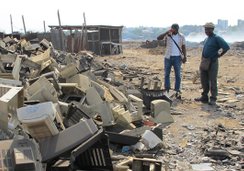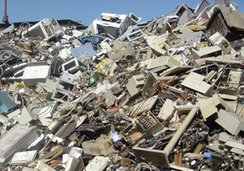


Dangers
Electronic waste is potentially very harmful. They are made of multitude of components, some containing toxic hazardous substances that have an adverse impact on human health and the environment if not handled properly.

Hazardous compounds
These are organic and inorganic compounds.
Organic compounds include various brominated flame retardants, brominated and chlorinated dioxins (PCDD/Fs and PBDD/Fs), brominated and chlorinated benzenes and phenols, polychlorinated biphenyls (PCBs) and naphthalenes (PCNs), polycyclic aromatic hydrocarbons (PAHs), nonylphenol, organophosphorus flame retardants, phthalate esters and Freons.
Inorganic compounds include antimony, arsenic, asbestos, barium, beryllium, cadmium, chromium, copper, lead, mercury, nickel, selenium, tin, yttrium, and zinc. Some are of concern because they are very toxic while others mainly because they are abundant in e-waste.
Some more discrete chemicals of concern are present in E-waste. These are liquid crystals from liquid crystal displays (LCDs), toner dust from toner cartridges and nano-particles from various products.
The components and materials that are of most concern are: printed circuit boards (PC-boards), batteries, cathode ray tubes (CRTs), LCDs, plastics, PCB-containing capacitors, equipment containing freons, toner cartridges and various mercury containing components.
Hazardous Substances in WEEE
Health and environmental impact of E-waste
EEEs are made of a multitude of components, some containing toxic substances that have an adverse impact on human health and the environment if not handled properly. Often, these hazards arise due to the improper recycling and disposal processes used.
Toxic substances can be found within the following types of emissions or outputs:
•leachates from dumping activities
•particulate matter (coarse and fine particles) from dismantling activities
•fly and bottom ashes from burning activities
•fumes from mercury amalgamate “cooking”, desoldering and other burning activities
•wastewater from dismantling and shredding facilities
•effluents from cyanide leaching and other leaching activities
E-waste can contain more than one thousand different substances, many of which are toxic. These can comprise heavy metals, for example mercury, lead, cadmium, and chromium, and flame retardants, including polybrominated biphenyls (PBBs), polychlorinated biphenyls (PCBs) and polybrominated diphenyl ethers (PBDEs) as well as radioactive Americanium found in medical equipment.
The most hazardous components of e-waste are the mercury-containing components, batteries, printed circuit boards, CRTs, and the plastics which contain the brominated flame retardants.
Leaching and evaporation of these substances occurs at the e-waste sites, and results in the contamination of surrounding natural resources including, soils, crops, drinking water, livestock and fish.
In addition to the environmental concerns, the hazardous materials found in e-waste pose a significant risk to human health. Studies show that health-damaging exposure to e-waste can result in long-term, often irreversible effects, such as infertility, miscarriage, tumors, endocrine diseases and birth defects. The workers often suffer from cuts, coughs, headaches, upper respiratory problems, rashes and burns.
Towards a
Pollution-Free Planet


